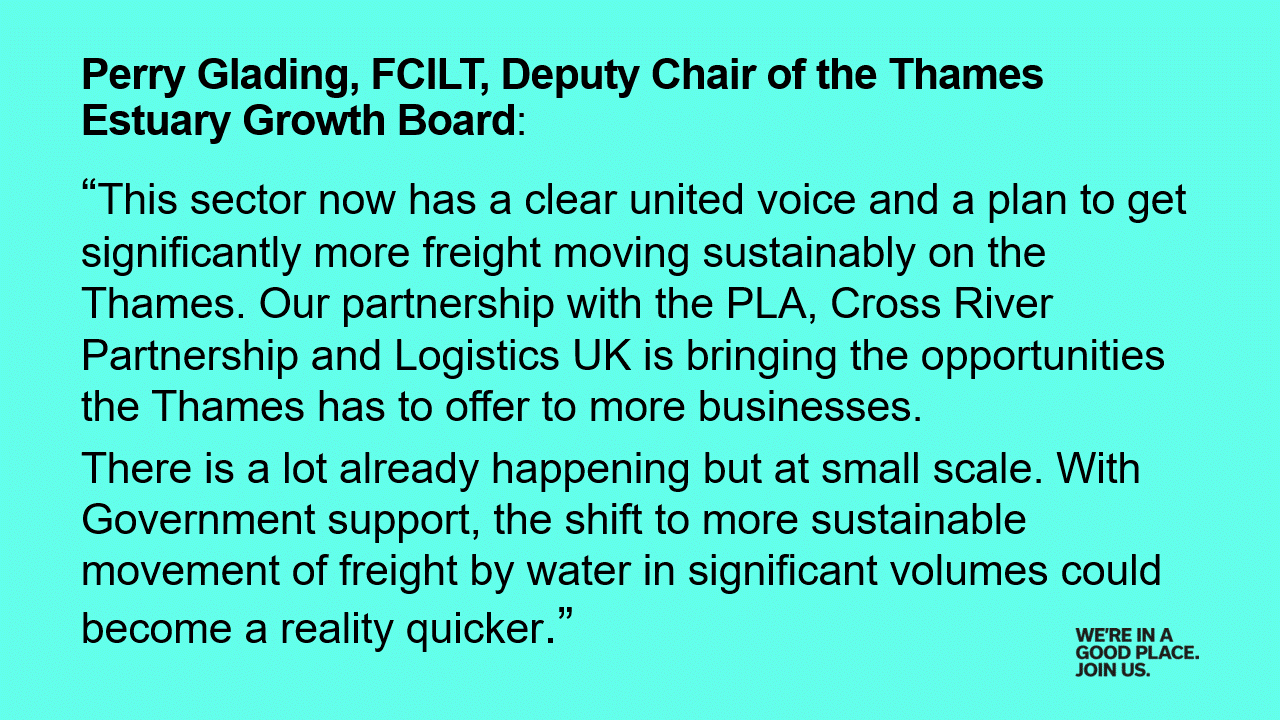The Thames Estuary Growth Board held its second ‘Light Freight on the River Thames’ round table on 8 July 2022, in partnership with the Port of London Authority, Cross River Partnership (CRP) and Logistics UK who kindly hosted the event. The objective was to demonstrate to decision-makers across the sector the range of work and evidence supporting using the river to move freight.
Support for river freight is growing with businesses interested in benefitting from the reliability of a river deliveries, as well as its emission and congestion-cutting potential. Alongside rail, the river can be part of the solution to decarbonising freight. Well-known brands are already using the river and more household names are planning to launch trials in 2022.
The main theme of the event was the launch of the ‘Mode Shift Revenue Support (MSRS) – Light Freight Analysis Report’ that was co-commissioned by the Growth Board and the PLA. Developed in response to requests raised at the February round table, the report developed by WSP analysed the Mode Shift Revenue Support funding scheme from the Department for Transport (DfT) in respect of supporting the shift from road to water.
Key findings of the MSRS Analysis
WSP presented the MSRS analysis and the main recommendations for revising the current scheme in order to better support freight shift to river, in summary:
- Changing assessment criteria.
- Incentivising innovation.
- Including grant funding for the purposes of capital expenditure.
- Developing a pilot study around light freight operations for specific movements, in order to test alternative mode shift support mechanisms or initiatives.
Discussion of the MSRS, opportunities and next steps
Over 40 leaders from across the light freight ecosystem discussed the MSRS findings and highlighted the following:
- Absence of necessary infrastructure that is a barrier of the efficient usage of water.
- Those who have piloted services using the Thames spoke of the high level of reliability of waterborne transport which achieved on time delivery 97% of the time.
- Recognising that while these pilots are demystifying the usage of the Thames for light freight shipping, they do not address the viability problems.
- Additional aspects the MSRS analysis could include: environmental impact, diesel price increase or the introduction of multi stops.
- Acknowledgement that there are other locations worldwide where use of river is much more advanced, and the city has to be ready to attract investors.
Perry Glading FCILT, Deputy Chair of the Thames Estuary Growth Board, summarises the round table discussions and next steps for supporting light freight on the river Thames in the short video below.
The MSRS analysis adds to growing evidence supporting the development of a thriving river economy.
Evidence and support for developing light freight on the Thames
CRP introduced some of their innovative work as part of Clean Air Villages 4 and Clean Air Logistics for London, to support light freight along on the Thames, including:
- A helpful, practical guide for businesses considering using the tidal Thames for freight. This document guides organisations through the processes, challenges and opportunities involved on using the river for operations.
- A first-of-its-kind river freight pilot, involving multiple pick-ups and organisations, presents an exciting opportunity for learning. CRP is currently working with the PLA on this pilot, and this is due to launch soon.
- Findings of a 4-month monitoring programme recording the real time impact on noise and emissions caused by river freight at piers and wharves, which supports moving from road to river.
- Light Freight Design Solutions for Thames Freight Infrastructure study that considers the design of London’s existing piers and the modifications required to make them suitable for a light freight service. The report, delivered in partnership with Beckett Rankine, PLA and Thames Estuary Growth Board, shortlists eight piers based on location, cost and environmental factors for supporting a light freight service.
- The newly launched Clean Air Logistics for London (CALL) project, which will move more freight into London via river rather than road, supported by zero emission delivery methods including electric vehicles, cargo bikes and walking freight.
Conclusion of Second Light Freight Round Table
Round table chair, Perry Glading, closed the meeting with a call for stakeholders to get in touch with the Growth Board if they wanted to join a steering group that could move this agenda forward. Interested stakeholders should contact enquiries@thamesestuary.org.uk
Read the full ‘MSRS River Freight Analysis Report’ and more about light freight.
Moving freight onto the river is a key part of the Thames Estuary Growth Board’s ‘Green Blue Workplan’, which describes practical steps to realising the huge potential of the Thames Estuary.
To become part of this exciting economy, contact any of the lead partners:
- Thames Estuary Growth Board enquiries@thamesestuary.org.uk
- PLA
- CRP
- Logistics UK
We’re in a good place. Join us.

